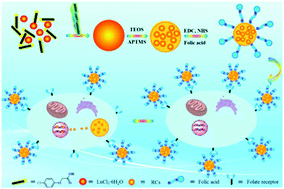当前位置:
X-MOL 学术
›
Dalton Trans.
›
论文详情
Our official English website, www.x-mol.net, welcomes your feedback! (Note: you will need to create a separate account there.)
Facile synthesis of highly biocompatible folic acid-functionalised SiO2 nanoparticles encapsulating rare-earth metal complexes, and their application in targeted drug delivery
Dalton Transactions ( IF 4 ) Pub Date : 2017-10-18 00:00:00 , DOI: 10.1039/c7dt03000b Xiuling Xu 1, 2, 3, 4, 5 , Fan Hu 1, 2, 3, 4, 5 , Qi Shuai 1, 2, 3, 4, 5
Dalton Transactions ( IF 4 ) Pub Date : 2017-10-18 00:00:00 , DOI: 10.1039/c7dt03000b Xiuling Xu 1, 2, 3, 4, 5 , Fan Hu 1, 2, 3, 4, 5 , Qi Shuai 1, 2, 3, 4, 5
Affiliation

|
Mesoporous silica core–shell nanospheres encapsulating a rare-earth metal complex (RC) were first synthesised through a facile W/O (water in oil) inverse microemulsion method. In order to achieve targeted complex delivery, folic acid (FA) was used as the targeting component due to its high affinity for over-expressed folate receptors (FRs) in cancer cells. The RC2@SiO2-FA nanospheres were characterised via ultraviolet-visible light absorption spectroscopy (UV-vis spectroscopy), dynamic light scattering (DLS), scanning electron microscopy (SEM) and transmission electron microscopy (TEM). A microwave method was used to synthesise five RC cores based on 4-chlorophenoxyacetic acid, and their crystal structures were further confirmed using X-ray diffraction. The five RC cores have the following chemical formulae: [Er2(p-CPA)6(H2O)6] RC1, [Ho2(p-CPA)6(H2O)6] RC2, [Sm(p-CPA)3(H2O)] RC3, [Pr(p-CPA)3(H2O)]·3H2O RC4 and [Ce(p-CPA)3(H2O)2]·2H2O RC5. The carboxyl groups showed two kinds of coordination modes, namely μ2–η1:η1 and μ2–η1:η2, among RC1–RC5. The flexible –OCH2COO– spacer group, which can undergo rotation of its C–O and C–C bonds, offered great potential for structural diversity. In vivo experiments revealed that the nanospheres exhibited no obvious cytotoxicity on HepG2 cells and 293 T cells, even at concentrations of up to 80 μg mL−1. Nevertheless, all of the RC cores showed a certain degree of anti-tumour efficacy; in particular, RC2 showed the strongest cytotoxicity against HepG2 cells. Interestingly, the cytotoxicity of all of the RC2@SiO2-FA nanospheres was higher than that of lone RC2. These types of FA-targeted mesoporous silica nanocarriers can be used for the delivery of anti-tumour RC, and provide a basis for the further study of affordable non-platinum-based complexes.
中文翻译:

高生物相容性的稀土金属配合物叶酸官能化的SiO 2纳米颗粒的简便合成及其在靶向药物递送中的应用
首先通过一种简便的W / O(油中水)反相微乳化法合成了包封稀土金属配合物(RC)的介孔二氧化硅核-壳纳米球。为了实现靶向的复合物递送,叶酸(FA)被用作靶向成分,因为它对癌细胞中过度表达的叶酸受体(FRs)具有很高的亲和力。RC 2 @SiO 2 -FA纳米球的特征是通过紫外可见光吸收光谱(UV-vis光谱),动态光散射(DLS),扫描电子显微镜(SEM)和透射电子显微镜(TEM)。使用微波法合成了基于4-氯苯氧乙酸的五个RC核,并使用X射线衍射进一步确定了它们的晶体结构。五个RC核具有以下化学式:[Er 2(p -CPA)6(H 2 O)6 ] RC 1,[Ho 2(p -CPA)6(H 2 O)6 ] RC 2,[Sm (p-每次转化费用)3(H 2 O)] RC 3,[Pr(p -CPA)3(H 2 O)]·3H 2 O RC 4和[Ce(p -CPA)3(H 2 O)2 ]·2H 2 O RC 5。羧基可见两类协调模式,即μ 2 -η 1:η 1和μ 2 -η 1:η 2,RC间1 -RC 5。灵活的–OCH 2可以经历其C–O和C–C键旋转的COO–间隔基团为结构多样性提供了巨大潜力。体内实验显示,即使浓度高达80μgmL -1,纳米球对HepG2细胞和293 T细胞也没有表现出明显的细胞毒性。尽管如此,所有的RC核心都显示出一定程度的抗肿瘤功效。特别是,RC 2对HepG2细胞显示出最强的细胞毒性。有趣的是,所有RC 2 @SiO 2 -FA纳米球的细胞毒性都比单独的RC 2高。。这些类型的靶向FA的介孔二氧化硅纳米载体可用于抗肿瘤RC的传递,并为进一步研究可负担的非铂基复合物提供了基础。
更新日期:2017-11-15
中文翻译:

高生物相容性的稀土金属配合物叶酸官能化的SiO 2纳米颗粒的简便合成及其在靶向药物递送中的应用
首先通过一种简便的W / O(油中水)反相微乳化法合成了包封稀土金属配合物(RC)的介孔二氧化硅核-壳纳米球。为了实现靶向的复合物递送,叶酸(FA)被用作靶向成分,因为它对癌细胞中过度表达的叶酸受体(FRs)具有很高的亲和力。RC 2 @SiO 2 -FA纳米球的特征是通过紫外可见光吸收光谱(UV-vis光谱),动态光散射(DLS),扫描电子显微镜(SEM)和透射电子显微镜(TEM)。使用微波法合成了基于4-氯苯氧乙酸的五个RC核,并使用X射线衍射进一步确定了它们的晶体结构。五个RC核具有以下化学式:[Er 2(p -CPA)6(H 2 O)6 ] RC 1,[Ho 2(p -CPA)6(H 2 O)6 ] RC 2,[Sm (p-每次转化费用)3(H 2 O)] RC 3,[Pr(p -CPA)3(H 2 O)]·3H 2 O RC 4和[Ce(p -CPA)3(H 2 O)2 ]·2H 2 O RC 5。羧基可见两类协调模式,即μ 2 -η 1:η 1和μ 2 -η 1:η 2,RC间1 -RC 5。灵活的–OCH 2可以经历其C–O和C–C键旋转的COO–间隔基团为结构多样性提供了巨大潜力。体内实验显示,即使浓度高达80μgmL -1,纳米球对HepG2细胞和293 T细胞也没有表现出明显的细胞毒性。尽管如此,所有的RC核心都显示出一定程度的抗肿瘤功效。特别是,RC 2对HepG2细胞显示出最强的细胞毒性。有趣的是,所有RC 2 @SiO 2 -FA纳米球的细胞毒性都比单独的RC 2高。。这些类型的靶向FA的介孔二氧化硅纳米载体可用于抗肿瘤RC的传递,并为进一步研究可负担的非铂基复合物提供了基础。



























 京公网安备 11010802027423号
京公网安备 11010802027423号